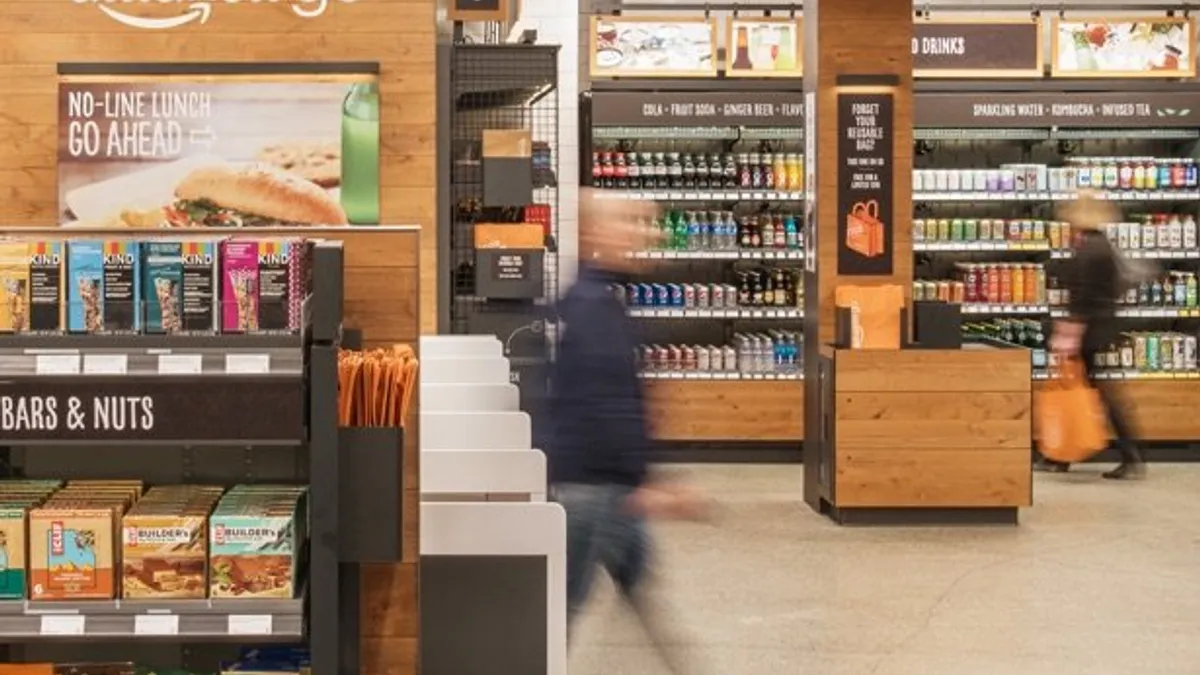Dive Brief:
- While 84% of people said they would likely enjoy shopping at Amazon Go compared to a regular brick-and-mortar location, 20% said they would be losing out on something important by shopping at Amazon Go versus at a traditional grocer, according to a survey of 1,000 Americans by Shorr Packaging Corp. The biggest drawbacks included the inability to use coupons, the lack of product selection, the absence of social interaction and not being able to pay with cash.
- Even though 75% of people surveyed said they would likely shop at an Amazon Go if one were located nearby, baby boomers were more skeptical. The survey found that 30% of the generation would be unlikely to shop at Amazon Go even if it were conveniently located. This survey comes shortly after Amazon announced the expansion of its Amazon Go stores beyond Seattle to Chicago and San Francisco.
- Shorr also found 32% of people surveyed said they would have less preference for specific brands at Amazon Go. This increases the need to have the best food packaging and branding to help persuade the Amazon Go shopper, the packaging company said.
Dive Insight:
Reports have shown that checkout wait times are a major headache for consumers. Although self-checkout has been marketed as a solution to this problem, some studies have found the method doesn't actually save consumers any time. It also increases the likelihood of theft.
For Amazon, it’s working on a hands-off shopping experience called Amazon Go. After a number of technical delays, Amazon Go finally pulled back the curtain on its much-touted cashier-less store at the end of January. So far, it has been a hit with the company reportedly planning to open another a half dozen locations in different markets this year. With 84% of people anticipating a stress-free shopping experience, it’s no wonder that Amazon is pushing the rapid expansion of a concept.
However, many older people are not as thrilled by the idea of losing the traditional shopping experience as baby boomers. It's not a surprise that older generations are typically slower at adopting emerging technology than younger customers. However, Amazon, a company that is not afraid to take an initial profit loss in hopes of changing consumer habits, is investing in the future and hopes that hesitant customers will eventually become comfortable with the technology.
The company might consider reaching out to organizations that work with these consumers or sponsor events where they gather in hopes of convincing them to embrace Amazon Go. The company also will naturally benefit from expansion of the concept to other cities, prompting more people to understand how it works, that it actually does work and how it can save them more time.
In an industry beset by thin margins, Amazon is not alone in investing in technology to cut operating costs. Other retailers such as Walmart, Meijer and Kroger have launched their own versions of the scan-and-go concept.
But Walmart has since ended its own cashierless service as it moves ahead with a different practice that relies on employees with mobile devices to accelerate the checkout experience. According to CBC News, it was challenging for shoppers to bag, weigh and scan items like produce, causing most to head to traditional checkout counters.
The shuttering of Walmart’s much-hyped service is a reminder that there is still much to be sorted out with this model. Nonetheless, Juniper Research estimates cashierless transactions will reach $78 billion by 2022, up from an anticipated $9.8 billion in 2017. But for now, the research firm found the limited adoption of cashierless checkout hardware has to do with the cost and complexity of infrastructure integration and bringing these systems into wider use.
Still, if Amazon passes along some of the costs to their customers in the name of convenience, they may not receive such a warm welcome. Although consumers are begging for an expedited shopping experience, only 25% said they are willing to pay more for it. Despite time being money, it seems there is a limit to how much customers are willing to pay to not have to stand in line.
Although innovative, it seems that Amazon Go has a long way to travel before it becomes the standard of convenience in the grocery space. Proximity and choice are going to play a major role in transforming their outlets from a convenience store replacement into a full-fledged grocery shopping destination. Still, they have a good chance. As more consumers become increasingly comfortable with mobile payments and nontraditional checkout options, the "store of the future" model by grocers and retailers may see major growth in the years to come with its added convenience and friction-free experience.








